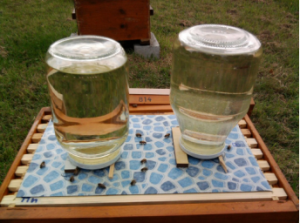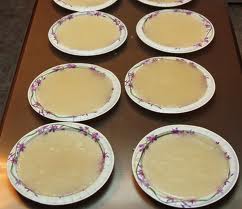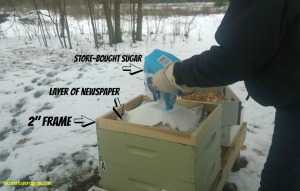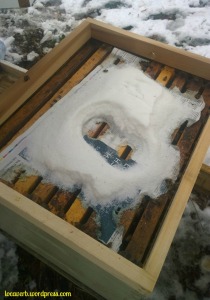It’s great when your bees provide food for you, but every so often in a beekeeper’s career, she provides food for the bees. There are a million opinions about whether or not one should feed bees throughout the year and a million and one opinions about how this feeding should happen. I’m simply going to explain one feeding method that we have tried this year, the reason why, and our experience with it thus far.
As you may remember, none of my four hives produced very much honey this year, so my husband and I knew that we were going to have to feed throughout the winter if we had any hope of the bees surviving. When beekeepers feed in the winter, they generally feed a sugar-water mixture. This can be made and served in various forms:
- Syrup- To make this feed you use a sugar to water ratio (changes depending on the thickness you desire). Your success with this method depends a lot on the container you use to hold the liquid. It can be messy and if it drips too quickly or leaks, your bees can drown. In the winter, the liquid can freeze, so it’s not really a winter-feeding option (in Michigan, at least!). These recipes are very flexible, so they can take anywhere from 2 cups of sugar to 10 pounds (depending on how much syrup you need, of course).
- Fondant- This is fairly easy to do. Here’s a great how-to. You can make fondant easily at home and harden it in any size mold or container you want. This is the method my husband and I usually use, assuming the bees have a normal amount of honey in the fall. We make fondant “cakes” (I harden them in a silicone muffin pan) and then in those first few weeks of spring when the snow has melted, but the dandelions aren’t up yet, we throw a few in each hive. We generally make ours out of one or two five pound bags of sugar and then make more as needed (depends how many hives you are feeding, of course). In the image below, Rusty from HoneyBeeSuite has used paper plates as her molds.
- Candyboard- This is similar to fondant, but a better option if you need to feed long-term (like all winter, ahem). Here’s a nice tutorial. You basically make a giant fondant board and place it at the top of the hive, so the bees can eat all winter. Making one of these requires about 12-16 lbs of sugar.As we faced a winter of feeding, we decided to do some research just to be sure that a candyboard was our best option. In our research, we stumbled up the Mountain Camp method and decided, Why not? Beekeeping is about taking chances. Let’s give a try!
Mountain Camp Method
What is it?
The Mountain Camp Method, simply put, is feeding with dry sugar. It differs from the methods listed above because you use no water or heat to prepare the sugar.
The name came from a beekeeping message board on BeeSource.com. A user, named Mountain Camp, introduced it. It plays on the idea that when you are camping, you often have to rely on simplified methods of doing things and so he offered this simplified feeding method.
Set-Up
It’s pretty simple. In fact, so simple that when my husband and I finished our first hive I said, “There’s no way this will work. It’s too easy!”
What we did was take the hive cover off and placed a rim feeder that my husband built. It was maybe two-three inches deep. You could probably use an empty box, but we didn’t want to run the risk that the bees would build comb in there. Not to mention, in the winter we want as little air space as possible to keep the hive warm. You can buy rim feeders, but we built ours out of scrap wood.
We then put down a layer of newspaper, just one or two sheets thick. Lay this right on the tops of the frames. It doesn’t need to fit edge-to-edge, in fact a piece that lays in the middle and leaves about an inch around the edges works great. Most importantly, you don’t want any of the newspaper to hang outside of the hive. If this happens, the paper will get wet and the moisture will move right down the paper into your sugar and into your hive.
Then, we poured in sugar, direct from the bag. You’ll just pour as much sugar over the newspaper as you can fit without spilling into the hive.
- How It WorksThe bees keep the interior of the hive quite warm during the winter months and this heat and condensation works to kind of melt the newspaper as well as turn the exposed sugar into candy. When you make a fondant cake or a candyboard, you are basically adding water and heat to solidify the sugar. When you use this method of feeding, you are using the heat and moisture from the hive to do the work for you.Here’s what it looks like after the bees have started eating:
Does it Work?
So far, I can say yes. We peek under the lid whenever the weather is mild and all four hives are alive, thriving, and eating. When the sugar looks low, we dump a little more in. It’s still early, in terms of winter survival predictions, so it’s hard for me to completely endorse this method, but so far, this has worked well for us.
Of course you don’t want to open up the hive too much if it’s too cold or too windy. This winter has been great because there have been some mild days sprinkled throughout. If you must go into the hive (to add sugar, for example), just do it as quickly as possible.
One other benefit of this method I’ve been toying around with, is it seems like a great way to absorb excess moisture in a useful way. It’s a delicate balance keeping a hive warm, but not too moist due to condensation, so I like the idea of solving two problems at once.
Here are some other resources for this method:
Watch:
https://www.youtube.com/watch?v=xoUNDdcBx90
https://www.youtube.com/watch?v=HSmR5rAb8ss
Read:
http://www.honeybeesuite.com/mountain-camp-feeding/
http://www.indianahoney.org/2013/02/Mountain-Camp-Method-of-Feeding-Sugar.cfm
http://www.kybeeco.com/emergency-winter-feeding-bees/
I’m curious if anyone has experience with this method (either positive or negative) and, if so, would you share in the comments?




We’ve used this for years. We do it in the fall as part of winter prep, and then–of weather allows–peek in the winter and add sugar if needed. I figure it is good insurance. If they don’t use the sugar, typically it can be made into syrup come spring (unless it has too much dirt, debris, dead bees imbedded.)
I have been using the brenner method for years sense I had a hive that in my winter checks would always find the bees contracting around the top inner cover. So I started once a month or so dumping a couple of table spoons of powered sugar at the inner cover center hole, (no need of exposing the bees by taking off the inner cover) . It also helps absorb moisture and it doesn’t end up on the bottom board because it doesn’t flow as easy as granule sugar.
In the spring as soon as I could inspect the hive I found no honey in the hive. So I saved the bees. I have been doing this ever sense just for good measure. Last winter I didn’t loose any colonies. If you think this crazy that is OK but the success has convinced me.
Also you can tell if there is any activity by them working on the sugar and it gives them something to do. If you decide to this no not cover the center hole, maybe just a third of it. It’s the easiest method I have found.